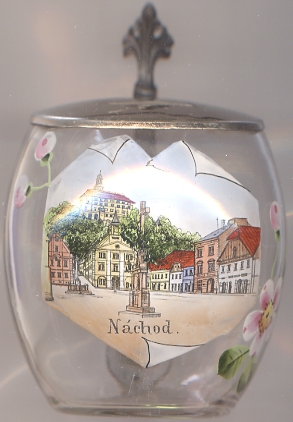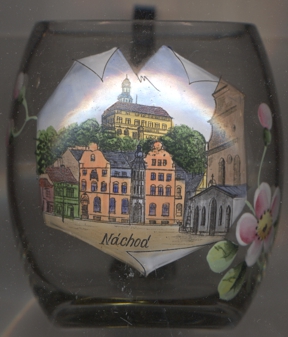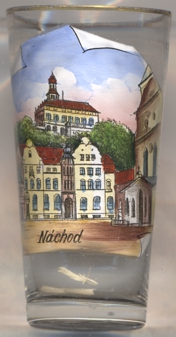

|
| ČESKÁ REPUBLIKA | CZECH REPUBLIC |
| Královéhradecký kraj | Hradec Králové region |
| Okres: Náchod |
Náchod is situated at an elevation of 346 m on the river Metuje in eastern Bohemia near the border to Poland. The town's quarter of Běloves borders Słone, a district of Kudowa-Zdrój in Poland. Náchod is the seat of the administration of the district of the same name in the region Hrádec Králové. The municipality has a population of about 20,400 (2013) and also includes the localities Babí (German: Babe), Běloves (Bielowes, see below), Bražec (Braschetz), Dobrošov (Dobroschau), Jizbice (Jisbitz), Lipí (Lip), Malé Poříčí (Klein Poritsch), Pavlišov (Paulisch) und Staré Město nad Metují (Altstadt an der Mettau).
 The area of Náchod was first mentioned in the Chronica Boemorum, written by Cosmas of Prague in 1119–125, who refered to the town as the 'gate to Poland'.
A castle was built in this strategic position around 1250 to safeguard the border. The town was presumably founded at the same time; the first mention of Náchod
in a document dates from 1254 and is found in a document that confirms the river Židovka (then named Stekelnice or flumen Zürbcsca) as the border between the
domains of Náchod and those of the Benedictine monastery of Police nad Metují.
Náchod obtained the privileges of a market town in the 15th century. Subsequently, Náchod became an important trading place on the road to the
Kłodzko (Glatz) area and beyond to Wrocław (Breslau).
In 1866 the Battle of Náchod between Prussian and Austrian troops took place near the town; the battle ended with a victory by Prussia.
The area of Náchod was first mentioned in the Chronica Boemorum, written by Cosmas of Prague in 1119–125, who refered to the town as the 'gate to Poland'.
A castle was built in this strategic position around 1250 to safeguard the border. The town was presumably founded at the same time; the first mention of Náchod
in a document dates from 1254 and is found in a document that confirms the river Židovka (then named Stekelnice or flumen Zürbcsca) as the border between the
domains of Náchod and those of the Benedictine monastery of Police nad Metují.
Náchod obtained the privileges of a market town in the 15th century. Subsequently, Náchod became an important trading place on the road to the
Kłodzko (Glatz) area and beyond to Wrocław (Breslau).
In 1866 the Battle of Náchod between Prussian and Austrian troops took place near the town; the battle ended with a victory by Prussia.
 Náchod castle [background top] goes back to the border fortress that was built in this place around 1250.
Throughout the following centuries the castle was repeatedly rebuilt and enlarged. The owners of the castle changed frequently and included
the Bohemian kings John of Luxembourg and Jiří of Poděbrady.
In 1554–1614 the castle was remodeled into a representative Renaissance residence by the lords Smiřický of Smiřice. As these were
followers of Elector-Palatine Friedrich V (Friedrich I as 'Winter King' of Bohemia 1619/1620), the family was dispossessed after the
Battle of White Mountain (1620; today within Prague) and the castle was given to the Trčka of Lípa (today part of Všestary
near Hradec Králové). After the assassination of the last member of that family in 1634, the castle was given to Octavio Piccolomini,
general in the army of Emperor Ferdinand II. Piccolomini had the castle remodeled in Baroque style. In the late 18th century the castle theatre
was added by Peter of Biron, Duke of Courland and Zemgale and of Żagań. Since the mid-19th century the castle was owned by the princes of
Schaumburg-Lippe. The castle was seized in 1945 by the Czechoslovakian government and today is owned by the Czech state.
Náchod castle [background top] goes back to the border fortress that was built in this place around 1250.
Throughout the following centuries the castle was repeatedly rebuilt and enlarged. The owners of the castle changed frequently and included
the Bohemian kings John of Luxembourg and Jiří of Poděbrady.
In 1554–1614 the castle was remodeled into a representative Renaissance residence by the lords Smiřický of Smiřice. As these were
followers of Elector-Palatine Friedrich V (Friedrich I as 'Winter King' of Bohemia 1619/1620), the family was dispossessed after the
Battle of White Mountain (1620; today within Prague) and the castle was given to the Trčka of Lípa (today part of Všestary
near Hradec Králové). After the assassination of the last member of that family in 1634, the castle was given to Octavio Piccolomini,
general in the army of Emperor Ferdinand II. Piccolomini had the castle remodeled in Baroque style. In the late 18th century the castle theatre
was added by Peter of Biron, Duke of Courland and Zemgale and of Żagań. Since the mid-19th century the castle was owned by the princes of
Schaumburg-Lippe. The castle was seized in 1945 by the Czechoslovakian government and today is owned by the Czech state.
The  old town hall (stará radnice) [centre of the picture, below the castle]
was built in 1637–1659 by Carlo Lurago in Baroque style. In the mid-19th century it was remodeled in Classicist style.
old town hall (stará radnice) [centre of the picture, below the castle]
was built in 1637–1659 by Carlo Lurago in Baroque style. In the mid-19th century it was remodeled in Classicist style.
The  deanery (děkanství) [left, coloured in pale red]
was built in Baroque style in 1727 on the foundations of the former parsonage which itself had been built in 1566 and rebuilt in 1652.
deanery (děkanství) [left, coloured in pale red]
was built in Baroque style in 1727 on the foundations of the former parsonage which itself had been built in 1566 and rebuilt in 1652.
The Baroque  Trinity column (sloup Nejsvětěší Trojice) [background, in front of the deanery, barely visible]
was created in 1695.
Trinity column (sloup Nejsvětěší Trojice) [background, in front of the deanery, barely visible]
was created in 1695.
The  Crucifixion group [foreground] was created in 1799. The central column,
which carries the crucifix above the Virgin Mary, is flanked by two columns bearing the statues of St. Mary Magdalene
and St. John. In 1944, it was moved to the back of the presbytery of the church.
Crucifixion group [foreground] was created in 1799. The central column,
which carries the crucifix above the Virgin Mary, is flanked by two columns bearing the statues of St. Mary Magdalene
and St. John. In 1944, it was moved to the back of the presbytery of the church.

 The
The  parish church of St. Lawrence (farní kostel svatého Vavřince)
[near left, no. 4159, and right, no. 4164: far right, barely visible]
was originally built probably around 1310 in Gothic style. The church burnt down in 1441. Following the collapse of the wooden ceiling in 1570,
the nave was vaulted and the choir was added until 1578. The church was again destroyed during the fire of the entire town in 1663. After the fire,
both towers were lowered, the cornices were removed and were replaced by today's wooden superstructure. The last major changes to the building
were made in the 18th century.
parish church of St. Lawrence (farní kostel svatého Vavřince)
[near left, no. 4159, and right, no. 4164: far right, barely visible]
was originally built probably around 1310 in Gothic style. The church burnt down in 1441. Following the collapse of the wooden ceiling in 1570,
the nave was vaulted and the choir was added until 1578. The church was again destroyed during the fire of the entire town in 1663. After the fire,
both towers were lowered, the cornices were removed and were replaced by today's wooden superstructure. The last major changes to the building
were made in the 18th century.
![3885 Náchod [Běloves]](glas3885.jpg) Běloves (in German: Bielowes) is a town district of Náchod, located on the Metuje river between
the city centre and the Polish border. Records of a ford across the river at this place are documented since 1068. The
mineral springs of Běloves are known since the 14th century, the oldest known document refering to them dating
from 1392. A spa was founded in 1818 and the waters were used for the treatment of diseases of the cardiovascular system and
other disorders. The spa was colsed several times during its history; the first time in 1866 during the Prussian-Austrian
War, again during World War I, in 1943 during World War II, and in 1979 due to a severe flooding. The spa was
nationalised in 1950 when it was taken over by the Central National Insurance Company; two years later it was transferred
to the Central Council of Trade Unions and in 1954 it returned to the state health administration. Although investments
into renovation of the old facilities were made in the 1960s and 1980s, the spa failed financially in the late 1990s and
was finally closed.
Běloves (in German: Bielowes) is a town district of Náchod, located on the Metuje river between
the city centre and the Polish border. Records of a ford across the river at this place are documented since 1068. The
mineral springs of Běloves are known since the 14th century, the oldest known document refering to them dating
from 1392. A spa was founded in 1818 and the waters were used for the treatment of diseases of the cardiovascular system and
other disorders. The spa was colsed several times during its history; the first time in 1866 during the Prussian-Austrian
War, again during World War I, in 1943 during World War II, and in 1979 due to a severe flooding. The spa was
nationalised in 1950 when it was taken over by the Central National Insurance Company; two years later it was transferred
to the Central Council of Trade Unions and in 1954 it returned to the state health administration. Although investments
into renovation of the old facilities were made in the 1960s and 1980s, the spa failed financially in the late 1990s and
was finally closed.
[de.wikipedia.org/wiki/Náchod, https://de.wikipedia.org/wiki/Chronica_Boemorum, https://de.wikipedia.org/wiki/Schloss_Náchod,
http://www.mestonachod.cz/mesto-nachod/pamatky/detail.asp?ID=143, http://in.ihned.cz/c1-16280110-nachod-synkopy-v-hudbe-i-architekture;
http://www.vybezek.eu/o-vybezku-sluknovskem-cestovani/59-vnitrozemi/2181-nachod-svaty-jan-nepomucky-a-sousosi-kalvarie.html;
https://cs.wikipedia.org/wiki/B%C4%9Bloves, https://cs.m.wikipedia.org/wiki/Lázne_Beloves;
https://cs.wikipedia.org/wiki/Kostel_svat%C3%A9ho_Vav%C5%99ince_(N%C3%A1chod)]
![[scale]](lineal.jpg)